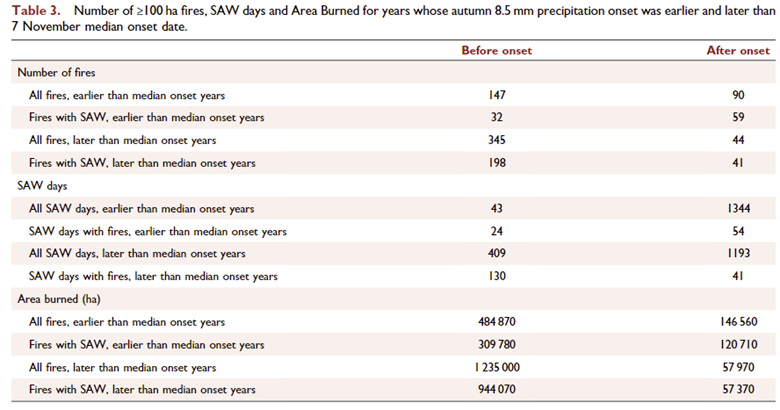CW3E Publication Notice
Autumn precipitation: the competition with Santa Ana winds in determining fire outcomes in Southern California
February 27, 2023
A new paper entitled “Autumn precipitation: the competition with Santa Ana winds in determining fire outcomes in southern California” was recently published in the International Journal of Wildland Fire by authors Daniel Cayan, Laurel DeHaan, Alexander Gershunov, and Joshua Mumford (SIO), as well as Janin Guzman-Morales (UC Santa Barbara), Jon Keeley (USGS/UCLA), and Alexandra Syphard (Conservation Biology Institute). These researchers investigate fire outcomes in California’s South Coast for the period 1948-2018, with respect to the opposing effects of two weather drivers: autumn precipitation and Santa Ana winds (SAWs). This study contributes to the goals of CW3E’s 2019-2024 Strategic Plan to advance monitoring and projections of climate variability and change by quantifying the odds that these weather drivers lead to fire outcomes.
Following typically dry, warm summers, the onset of autumn precipitation for California’s South Coast happens earlier in some years and later in others. For autumn precipitation onset, as defined in this study by the first 3 days when precipitation reaches or exceeds 8.5mm, the mean onset date is 7 November and the standard deviation is approximately 1 month. The onset date has had a negligible trend and there is considerable variation from year-to-year.
The results of this study indicate that the risk of large fires is reduced greatly after autumn precipitation onset. Focusing on fires that burned 100ha or greater, of all that occurred within autumn through winter, 79% started before the autumn precipitation onset. Most (37 of 40) of the South Coast’s very large (>10,000 ha) fires occur before autumn precipitation onset. Years with early onset autumn precipitation experienced considerably fewer fires and smaller burn areas (just 61% as many 100ha or larger fires and half as much area burns) than years with late onset, as shown below in Table 3 copied from the paper.
Additionally, the results obtained underscore the impact of SAWs in producing large fires. 34 of 40 of the South Coast’s largest fires started and spread during SAW events. Indeed, even after autumn precipitation onset, the risk of large fires resurges when SAWs are present. SAWs were involved with 47% of fires >100ha that started before onset, but they were involved in 75% of those fewer number of fires that started after onset.
The results of this study demonstrate the need for high levels of preparation and vigilance to avoid great fire impacts during the period of autumn before precipitation onset, and particularly during years with late autumn precipitation onset.
This research was funded by the U.S. Geological Survey through the Southwest Climate Adaptation Science Center, the California Department of Water Resources, Congressional Disaster Relief Supplemental Funding, and by San Diego Gas and Electric, however none of these sources were involved in the preparation of the data or the manuscript.
Cayan Daniel R., DeHaan Laurel L., Gershunov Alexander, Guzman-Morales Janin, Keeley Jon E., Mumford Joshua, Syphard Alexandra D. (2022) Autumn precipitation: the competition with Santa Ana winds in determining fire outcomes in southern California. International Journal of Wildland Fire , 31, 1056-1067. https://doi.org/10.1071/WF22065

